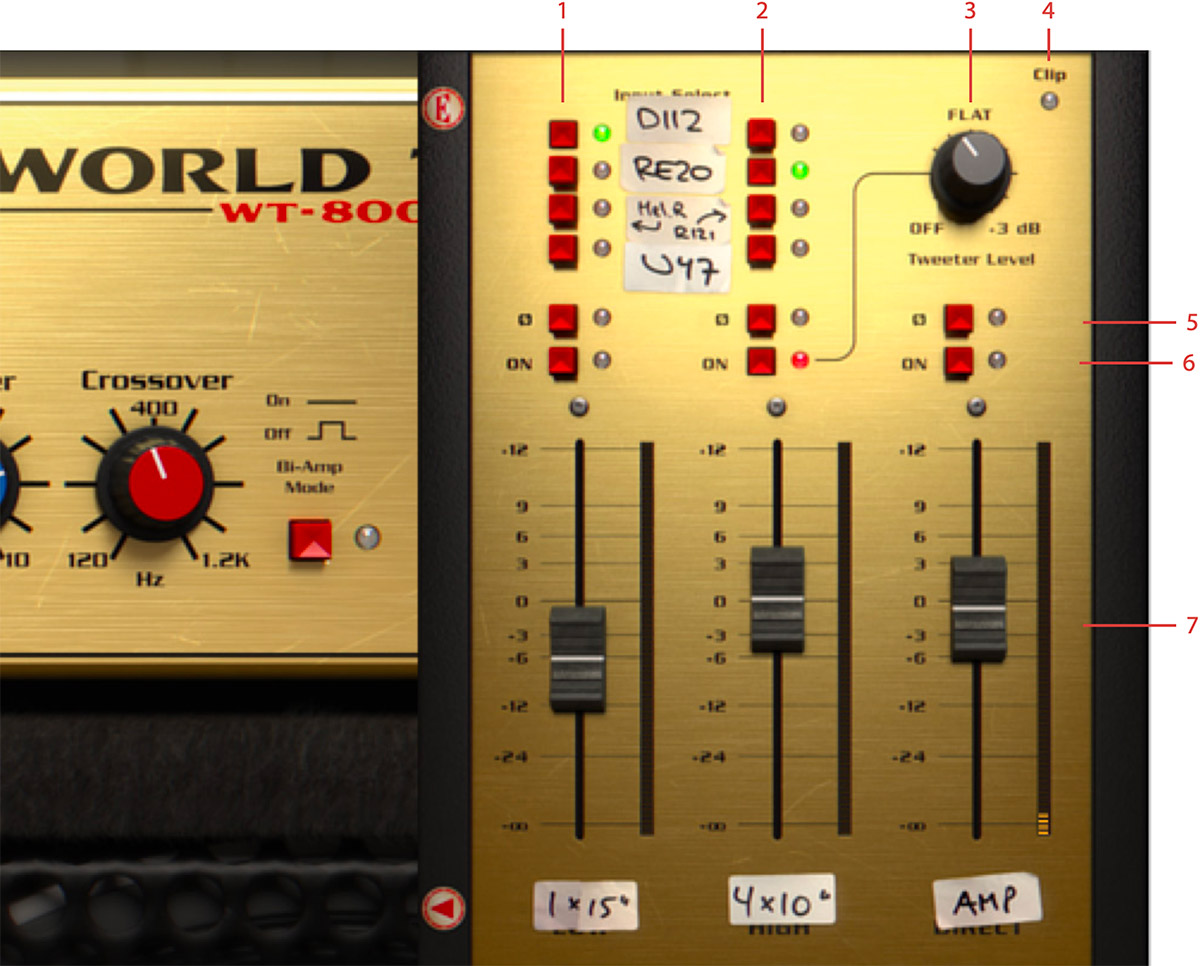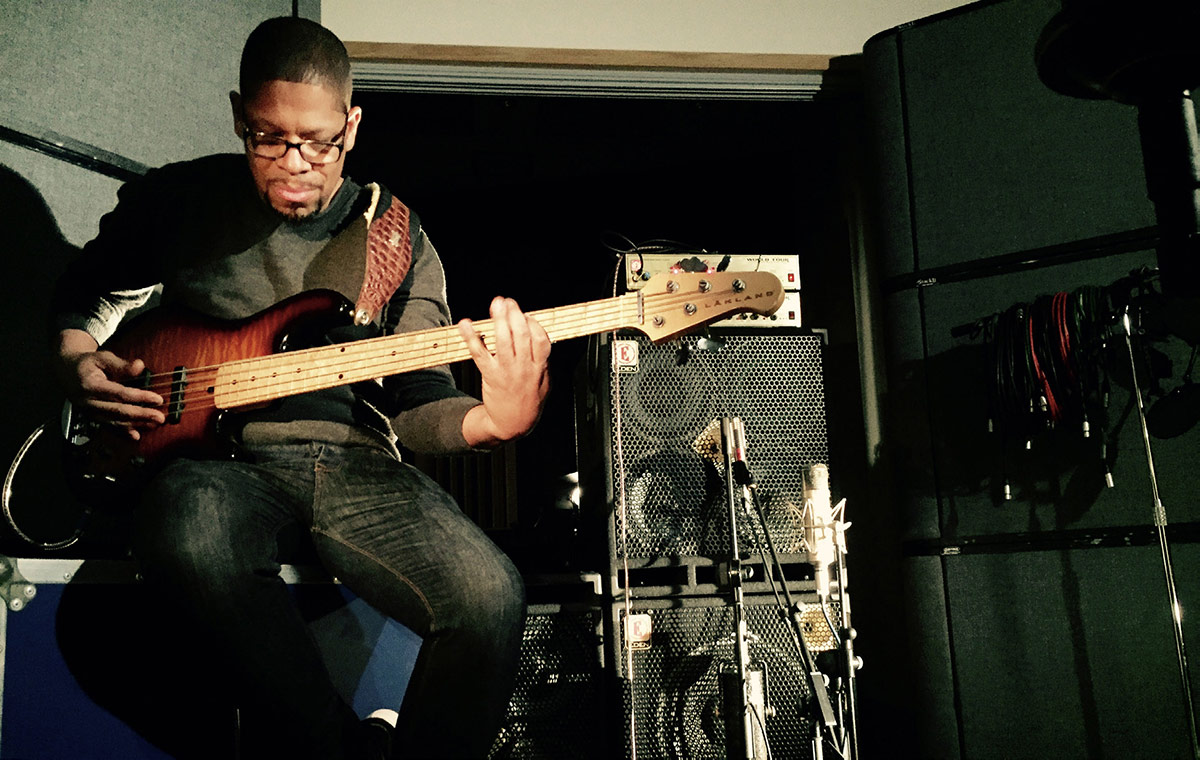User Manual
Eden WT-800 Bass Amplifier
Intro
User Interface
Cabinets and Microphones
Meters
Mono and Stereo Operation
Presets
Extended Features
Credits
Modern music production is all about the bass. Whether it’s a Moog synth line, a throbbing EDM rhythm or a poetic fretless bass, you need a solid and clean low end. The Eden WT-800 Bass Amplifier is the ultimate bass recording tool for producers and bass players alike.
Eden’s flagship bass amplifier WT-800 is heralded as one of the all-time great bass amps. Every detail has been fine-tuned for bass. The WT-800 plug-in does not only deliver the powerful and present sound of Eden’s high-end bass amp. It also includes models of Eden’s top of the line 4x10" and 1x15" cabinets, mic'd with four high-end studio microphones each. The mics were selected and positioned by producer and bass player Troy Antunes, known for his work with Justin Timberlake, NSYNC and Al Green. Troy Antunes has also provided some expertly designed presets. Unlike vintage style bass amps, Eden WT-800 delivers a modern, dynamic, and rock solid bass sound, flexible enough to be used for R’n’B, hiphop, metal or jazz.
Eden WT-800 extends beyond a bass amp model—it’s a fully featured tool for any bass instrument recording. Don’t limit yourself to only using it with bass guitars—it adds weight and focus to synth basses as well.
High fidelity for low frequency.
Simple as that.
If you are familiar with Softube's Marshall plug-ins, you'll recognize the hidden channel strip panel at the right. Click and drag the amp to the left, or click on the panel edge to reveal the channel strip.

Amplifier Parameters
Gain: Adjust input gain to the amplifier. Set it so that the green light is blinking when you're playing.
Enhance: The magic of Eden. This is a modern bass sound with the twist of a single knob. It's usually the first thing you adjust.
Bass, Treble: If you find a three band parametric EQ a bit much for a bass amp, start with the Bass and Treble. They work just as you would expect. The Bass is a type of shelving filter at around 100 Hz. Treble is a high shelving with center frequency at 4 kHz.
Low Gain/Frequency, Mid Gain/Frequency, High Gain/Frequency: A three band parametric equalizer; enhance the mid, tailor the highs or tame the low end.
Compressor: One knob compressor with a punchy attack and fat release. This compressor will add more punch and attack to your tone, rather than destroy the transients. If you play with a soft touch you'll get a looong sustain with a bit of compressor dialed in. The Input Gain will also affect the amount of compression, so a higher input gain will lead to more compression.
G. R. LED: The gain reduction LED lights up when the compressor is limiting the output volume.
Master: Main volume. Use this as the primary, overall, output volume knob.
Crossover, Bi-Amp Mode: In Bi-Amp Mode, the output from the amp is split up into a low frequency and a high frequency part with the crossover frequency set by the Crossover knob. The low frequency signal is fed to the 1x15" cabinet, and the high frequency signal to the 4x10". With Bi-Amp Mode engaged, you can get a very clear and solid mid-range.

-
Compressor
-
Gain
-
Gain
-
Bass
-
Low gain/Frequency, Mid gain/Frequency, High gain/Frequency
-
Treble
-
Master
-
Crossover, Bi-Amp mode
-
Open channel strip
Channel Strip Parameters
The channel strip consists of three channels: the mic on the bassy 1x15" cabinet, the mic in front of the brighter and more well-balanced 4x10" cabinet as well as audio direct from the amplifier. This is not the signal from one of the original WT-800's built-in direct outputs, but an output taken from the end of the amplifier; after the Master Volume.
Mic Selection (only 1x15" and 4x10" channels): Both the 1x15" and 4x10" cabinet has a selection of four different mics. Select which mic to use with these two columns with four radio buttons. For more information regarding the microphones, see the section below.
Phase Invert (all channels): Phase inverts the audio on that channel. Keep in mind, there is no "correct" phase when it comes to bass. Flip the phase and see what happens. If you like the sound, keep it, otherwise flip it again.
In (all channels): Turn on the audio on that channel.
Level (all channels): Set the level of the respective channel.
Tweeter Level (only 4x10" channel): Turn up for more high frequencies from the 4x10" cabinet. The 4x10" has a built-in tweeter, with a level control on the back. This knob adjusts that level.
Meters, Clip LED: The channel meters show the peak levels of each channel. The Clip LED at the top right lights up when the output signal exceeds 0 dB.

-
Mic selection 1x15
-
Mic selection 4x10
-
Tweeter level 4x10
-
Clip LED
-
Phase invert
-
On/Off
-
Level and channel meters
How do I get a clear and uncolored tone with lots of headroom? That was the question that started Eden's quest for the perfect bass cab. They started building bass cabinets in the late 70s and their designs quickly became an industry standard for touring musicians. Since you didn't have to trade low end with clarity anymore, it's no wonder that it became a success.
The cabinets we chose to include in the Eden WT-800 plug-in are the cabinets most associated with that amp: the D410XLT and D115XLT.
The 4x10"
The D410XLT has a 4x10" speaker layout and dual ported design, and offers focused tone with exceptional low end. It is the perfect option when you need to project your sound through the mix and drive for ultimate lows.
The 1x15"
The D115XLT is a tuned and ported professional cabinet with a fast responding 15" speaker. It offers a classic rounded tone with great detail and response, coupled with a high temperature voice coil and our Eden cast bell tweeter. It's the option for players looking for a little more growl.

Troy Antunes during the Kore Studios sessions.
Microphones

1. Melodium Type R.
2. Setting up mics for the session.
3. The Royer R-121 and U 47.
Put three bass players in a room and there will be heated and long discussion about mics. But thanks to moderating non-bass players we managed to put the differences aside and come up with a roster of five diverse and very different sounding mics.
The AKG D112 has a classic scooped-out sound that just sounds right. Might feel a bit boring, but it does the job. Electro Voice's RE20 is another classic, with not as much of the lowest and highest as the D-112, but a focused and warm midrange. Neumann U 47 just has to be included. Full range, sparkling highs, nice and balanced. Can't go wrong there.
The final two mics are not studio classics for bass, but completes the palette in a very nice way. Royer's ribbon R-121 has a super smooth top, and tames the 4x10" like nothing else. It's sounds both aggressive and smooth at the same time (a passive/aggressive mic?). And last, but definitely not least: the huge Melodium Type R ribbon mic is as big as it sounds. Nothing sounds like that one.
George Apsion, owner of Kore Studios, and lucky owner of that particular mic says: "The Type R is a secret weapon for bass. It's an old French ribbon mic dating from the early 1940s. We were lucky enough to find one with the original ribbon intact and it has a huge low bump in the frequency response. There can't be many left out there, so it's a great feeling to hear it producing such immense sounds in a modern setting."
All cabinets and mics were recorded at Kore Studios, London, UK, by Troy Antunes, Niklas Odelholm, Kim Larsson and George Apsion.
The peak meters in the channel strip shows the peak level of each individual loudspeaker or direct from the amp. Even if all three meters are below 0 dB, that won't guarantee that the combined level is below 0 dB, since the sum of all can be higher. If the Clip LED at the top right corner of the channel strip is lit, you'll definitely above 0 dB. Please note that the Eden WT-800 plug-in won't limit the audio level at 0 dB, but can output much louder audio than that. So if you have a DAW that allows levels above 0 dB, you don't have to bother too much about the Clip LED.
The Eden WT-800 is in its most basic form a mono plug-in, but if you place a stereo instance of the Eden WT-800 on a track, it will process both channels independently. You can thus use the stereo version of Eden WT-800 as an effects processor on stereo sources, such as a stereo synth bass line or drum kit.
Many of the presets have a carefully tuned equalizer, sometimes to match a bass player, style, song or tonestack of a vintage amp. When adjusting presets, reach first for the Bass and Treble, Compressor, Enhance, cabinets, and lastly the semi-parametric equalizer. Compressor settings depends a lot on your input gain and bass, so it will always be necessary to adjust the amount of compression to your taste.

The real deal.
A whole range of added control can be accessed with Extended Features. Please see the separate "Extended Features" manual for more information.
Kim Larsson – Modeling, programming
Niklas Odelholm – Project management, sound design, graphic design, user manual
Arvid Rosén– Extremely complicated Sharc related stuff
Björn Rödseth – Programming
Patrik Holmström – Programming
Paul Shyrinskykh – Project management, quality assurance
Troy Antunes – Sound design, presets
Jerker Odelholm – Presets
Ulf "Rockis" Ivarsson – Presets
Ulf Ekelöf – 3D modeling